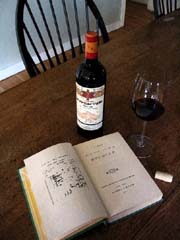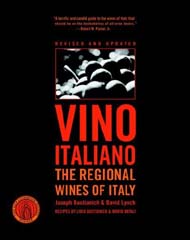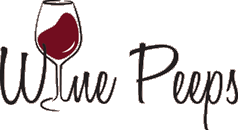Wine Book Club, First Edition: Vino Italiano
By Kori ~ February 26th, 2008.
 Today is the first “virtual meeting†of the Wine Book Club. The idea was originally proposed by Dr. Debs of Good Wine Under $20 and based on the model of Wine Blogging Wednesday. The concept brings together bloggers and wine lovers all over the world for book reviews and discussions every other month after reading a selected text. Our host for the first edition was David McDuff of McDuff’s Food & Wine Trail and the text he selected was Vino Italiano: The Regional Wines of Italy by Joseph Bastianich and David Lynch. As someone who has far too many unread books on my bookshelf and nightstand, this club was great motivation for me to actually get to reading.
Today is the first “virtual meeting†of the Wine Book Club. The idea was originally proposed by Dr. Debs of Good Wine Under $20 and based on the model of Wine Blogging Wednesday. The concept brings together bloggers and wine lovers all over the world for book reviews and discussions every other month after reading a selected text. Our host for the first edition was David McDuff of McDuff’s Food & Wine Trail and the text he selected was Vino Italiano: The Regional Wines of Italy by Joseph Bastianich and David Lynch. As someone who has far too many unread books on my bookshelf and nightstand, this club was great motivation for me to actually get to reading.
 At first the 531-page text seemed daunting but Vino Italiano is actually a very easy read. While I read the book from cover to cover (save for the reference material in Part III), the layout lends itself to use as a quick reference tool. And I am certain that I will be referring back to it frequently. The first section of the book, Part I: The Basics, covers just that—the basics of Italian wine history, laws, and labeling. The meat of the book, Part II: The Regions, covers each of Italy’s twenty-one regions, all of which produce wine. Each region’s chapter roughly follows the same format: introduction, map of the DOC zones of that region, and a discussion of the wines made in the region broken down into the following categories when applicable—Vini Spumante (sparkling wines), Vini Bianchi (white wines), Vini Rosati (rose wines), Vini Rossi (red wines), and Vini Dolci (sweet wines). Each chapter has a “Fast Facts†section that includes a few basic facts, key grape varieties, top vintages, wine touring information, and recommended tastings (all the recommended wines should be available in the American market). And, finally, each chapter concludes with an original recipe by either Mario Batali or Lidia Bastianich to showcase how regional foods and wines go together in Italy. Part III: The Data includes a glossary of Italian wine terms, a list of the grape varieties, a directory of DOC(G) and IGT zones, a list of producers, and additional miscellaneous resources.
At first the 531-page text seemed daunting but Vino Italiano is actually a very easy read. While I read the book from cover to cover (save for the reference material in Part III), the layout lends itself to use as a quick reference tool. And I am certain that I will be referring back to it frequently. The first section of the book, Part I: The Basics, covers just that—the basics of Italian wine history, laws, and labeling. The meat of the book, Part II: The Regions, covers each of Italy’s twenty-one regions, all of which produce wine. Each region’s chapter roughly follows the same format: introduction, map of the DOC zones of that region, and a discussion of the wines made in the region broken down into the following categories when applicable—Vini Spumante (sparkling wines), Vini Bianchi (white wines), Vini Rosati (rose wines), Vini Rossi (red wines), and Vini Dolci (sweet wines). Each chapter has a “Fast Facts†section that includes a few basic facts, key grape varieties, top vintages, wine touring information, and recommended tastings (all the recommended wines should be available in the American market). And, finally, each chapter concludes with an original recipe by either Mario Batali or Lidia Bastianich to showcase how regional foods and wines go together in Italy. Part III: The Data includes a glossary of Italian wine terms, a list of the grape varieties, a directory of DOC(G) and IGT zones, a list of producers, and additional miscellaneous resources.
As I learn more about Italy and their food and wine culture, I am continually amazed by how much a part of their everyday life it is. I am anxious to take a trip over there to experience it for myself.
Of all of Italy’s wine regions, chances are you have probably heard the most about Tuscany and very little, if any, about some of the others. As I mentioned in this month’s Wine Blogging Wednesday post, I have become particularly intrigued with learning more about Piedmont over the past year. Reading this book continued to fan that flame as it referred to Piedmont as the “wine-lover’s mecca.†Bastianich and Lynch made an interesting comparison between Tuscany and Piedmont:
“Tuscany is Italy’s Bordeaux, Piedmont its Burgundy: One is worldly and market-minded, the other more insular and scholarly. And both seem to like it that way.â€
Besides Piedmont, another region that now interests me is Basilicata. It is home to Aglianico del Vulture, arguably the best red wine of southern Italy. As the book says:
“Looking at the current scene, it almost goes without saying that Aglianico del Vulture is one of the new generation of collectible wines from Italy. While your friends are battling it out for rare (and often incredibly expensive) Barolo and Brunello, you might consider checking out Paternoster’s rare but relatively inexpensive “Rotondo†aglianico, D’Angelo’s “Canneto†and “Vigna Caselle,†or Nataio’s “La Firma†Aglianico del Vulture. All of them are assertively aromatic, packed with black-berry fruit and wrapped in wooly blankets of tannin that will preserve them for years. If you care about the wine, not the show, Basilicata is a place to consider. Get there before everyone else.â€
Vino Italiano did inspire me to try some new wines although I have not had an opportunity to do so yet. Some of the recommended tastings on my list to try are: Valtellina from Lombardia, Rosso Conero from Le Marche, Primitivo from Puglia, and Aglianico del Vulture from Basilicata.
I highly recommend this book to any wine lover interested in learning more about Italian wines, especially if you are considering a trip to Italy anytime soon. So head on over to Amazon or your book retailer of choice and pick yourself up a copy.
If you’ve already read the book, please leave a comment and let us know what you thought of it.
Filed under: Italian Wine, Wine Book Club, Wine Books

 Wine Peeps is an independent wine blog dedicated to helping you get the most bang for your buck in wine. We do this through blind tastings of wine from around the world and calculations of
Wine Peeps is an independent wine blog dedicated to helping you get the most bang for your buck in wine. We do this through blind tastings of wine from around the world and calculations of 











Well done, Kori. Thanks for participating. Just watch out for Piemonte. It will grab you and never let go. I visited for the first time in February 2006 and have been dying to get back ever since.
Great review Kori. I thought the book was outstanding, and it also encouraged me to try off the radar Italian varietals. I also agree that the book does a tremendous job of laying out the relationship between Italy’s food and wine culture, food being a must to truly enjoy the wine. I must say however, I was taken aback by the Veneto and it’s tradition of eating horse meat.
Thanks for the review, Kori. Like you, the book has me actually hunting for Italian wines that I had never heard of before I read the book. I think it is especially perfect for people who have been intimidated by the sheer number of Italian wines available. That we are not so familiar with Italian geography doesn’t help.